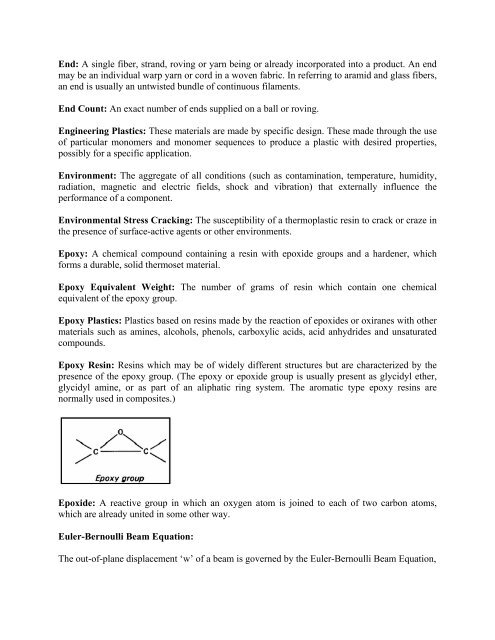Definitions /Dictionary/Glossary - nptel
Definitions /Dictionary/Glossary - nptel
Definitions /Dictionary/Glossary - nptel
Create successful ePaper yourself
Turn your PDF publications into a flip-book with our unique Google optimized e-Paper software.
End: A single fiber, strand, roving or yarn being or already incorporated into a product. An end<br />
may be an individual warp yarn or cord in a woven fabric. In referring to aramid and glass fibers,<br />
an end is usually an untwisted bundle of continuous filaments.<br />
End Count: An exact number of ends supplied on a ball or roving.<br />
Engineering Plastics: These materials are made by specific design. These made through the use<br />
of particular monomers and monomer sequences to produce a plastic with desired properties,<br />
possibly for a specific application.<br />
Environment: The aggregate of all conditions (such as contamination, temperature, humidity,<br />
radiation, magnetic and electric fields, shock and vibration) that externally influence the<br />
performance of a component.<br />
Environmental Stress Cracking: The susceptibility of a thermoplastic resin to crack or craze in<br />
the presence of surface-active agents or other environments.<br />
Epoxy: A chemical compound containing a resin with epoxide groups and a hardener, which<br />
forms a durable, solid thermoset material.<br />
Epoxy Equivalent Weight: The number of grams of resin which contain one chemical<br />
equivalent of the epoxy group.<br />
Epoxy Plastics: Plastics based on resins made by the reaction of epoxides or oxiranes with other<br />
materials such as amines, alcohols, phenols, carboxylic acids, acid anhydrides and unsaturated<br />
compounds.<br />
Epoxy Resin: Resins which may be of widely different structures but are characterized by the<br />
presence of the epoxy group. (The epoxy or epoxide group is usually present as glycidyl ether,<br />
glycidyl amine, or as part of an aliphatic ring system. The aromatic type epoxy resins are<br />
normally used in composites.)<br />
Epoxide: A reactive group in which an oxygen atom is joined to each of two carbon atoms,<br />
which are already united in some other way.<br />
Euler-Bernoulli Beam Equation:<br />
The out-of-plane displacement ‘w’ of a beam is governed by the Euler-Bernoulli Beam Equation,
















